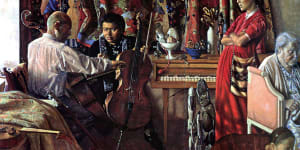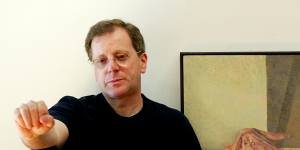Formal,detailed,realistic and beautifully painted,the same portrait submitted to the present-day Archibald would almost certainly end up in the Salon des Refusés.

Homage to John Reichard by Francis Giacco,winner of the 1994 Archibald Prize.Supplied
Even 29 years ago,there was a growing preference for more adventurous portraits and Giacco’s painting was viewed as a “conservative” choice – a word that induces shrieks of horror in contemporary art circles. It’s the usual response to anything realistic in style and executed with a conspicuous display of skill. Yet this is exactly the kind of work favoured by a public that has never lost its unfashionable preference for figurative painters working within the Western tradition.
Today,the gap between institutional and public taste has become a yawning chasm. It was once the museum’s duty to educate and instruct,to coax people away from their narrow prejudices,but now there is a zeal to instil a new form of bigotry that sees the entire history of art as a collection of sexist,racist and imperialist tropes that need to be overturned by “decolonising” public collections. There are many aspects to this program,but it consistently favours artists with a political agenda.
The result is that painters such as Francis Giacco,who were once part of a comfortable mainstream,have become marginalised by their concentration on traditional themes. Giacco’sRecent work:Pictures at an Exhibition (apologies to Mussorgsky), at Australian Galleries,is a 40-year survey that combines the most fastidious craftsmanship with a gradual exploration of favourite motifs,never departing from the familiar territory of portraiture,still life,figures and interiors.
Many paintings are so modestly scaled and executed they might properly be described as studies,but when Giacco sets out to produce a major work he approaches the task as if it were a military campaign. His compositions are complex,his colours and textures handled with extraordinary patience. He isn’t a showman,but there is a quiet determination to impress,in the immaculate way he paints a curtain,an article of clothing,a flower or a musical instrument.

Artist Francis Giacco with his painting Family Tradition.Jon Reid
The atmosphere of these paintings is private,even introverted. Many paintings feature Giacco himself and his family,but when he finds a model he likes,he will paint her again and again in the simplest poses – head and shoulder studies,reclining figures,demure nudes. It’s as if he needs to produce a quantity of less challenging pictures before embarking on a really ambitious one. He likes to tune up before the big gig.
It’s these major works that steal the show,not just theHomage to John Reichard,but an impressiveFamily Portrait (1994),in which Giacco depicts his Calabrian relatives turning every bit of a pig into smallgoods. There are memorable portraits of newsreader Lee Lin Chin (1993);actress Gosia Dobrowolska (1997),and inWhite Widow (1999-2000),the artist’s grandmother,who spent a large part of her married life on the other side of the world from her emigre husband.
There is something almost surreal aboutFamily Portrait,which includes four generations of Giaccos,from Francis’s grandmother to his two small daughters. The women devote their full concentration to the bits of pig that lie scattered on the table,while the artist’s father waves a guitar in the background. The scene is as stiff and unnatural as a Renaissance altarpiece,with the twin girls in their tiny fairy wings playing the role of cherubs. The sausages suspended from the ceiling seem to be striving to spell out a message. The women are the steady,practical ones,the father the artistic type.
Giacco apparently takes after his father,being an amateur composer and pianist as well as a painter. In this show,one may scan bar codes on the wall labels and download original snippets of music that relate to the pictures.
The artist is at his most ingenious inHomage to John Reichard,with its echoes of Vermeer,and oblique tribute to his cellist friend,who died before the painting could be exhibited. At first,Reichard,in his white shirt,seems to be only one element in a crowded panel,but we are induced to look at him by the intent gaze of two other figures,and by the way the composition subtly makes him the focal point. He is the subject of the portrait but in the most self-effacing manner – not posing for the artist but concentrating on the music he is making.
In recent years,Giacco’s palette has lightened up as he has ceased using the rare and difficult medium known as egg emulsion and turned to oils. The series of pictures he callsJenny’s Garden are bright and airy,filled with sunlight filtered through thin cane blinds. Cats,dogs,birds,plants,and still-life objects are deployed with great decorative freedom. One can sense the artist’s pleasure in these paintings.
InBalthus’ Cats (2020-23),Giacco pays his respects to one of his chief sources of inspiration,borrowing the nude,two cats and a mantelpiece,and giving them a personal twist. The new puritanism that has infected popular attitudes to art and literature makes it a brave gesture to associate oneself with the French artist Balthus (1908-2001),whose images of pubescent girls have rendered him a taboo figure for many people. The uncomfortable truth is that Balthus may have been a great fantasist and perhaps a great perv,but he was also a great painter.
Throughout the 20th century,as avant-garde movements passed in quick succession,Balthus devoted himself to the aesthetic values of the Renaissance. As an artist,he has more in common with Giotto and Piero della Francesca than with contemporaries such as Picasso and Matisse. He was one of the few figurative painters to be revered throughout the decades in which abstraction reigned triumphant.
Giacco has studied Balthus’ colour and tone,the space in his compositions,the way he deploys figures,animals and objects. What he lacks is the pervasive sense of eroticism found in Balthus’ work – a feeling that was only exacerbated by the artist’s persistent,straight-faced denials. In Giacco’s paintings there are plenty of sly references and personal symbols,but nothing that needs denying. While Balthus’s classicism is permeated with danger,Giacco’s is thoroughly domesticated. His paintings are civilised in the best sense,reflecting those bourgeois values of home,family and friendship that are the most reliable safeguards against the growing barbarism of our times.
Francis Giacco:Recent Work:Pictures at an Exhibition (apologies to Mussorgsky) is at theAustralian Galleries,Paddington,until July 2.
Find out the next TV,streaming series and movies to add to your must-sees..